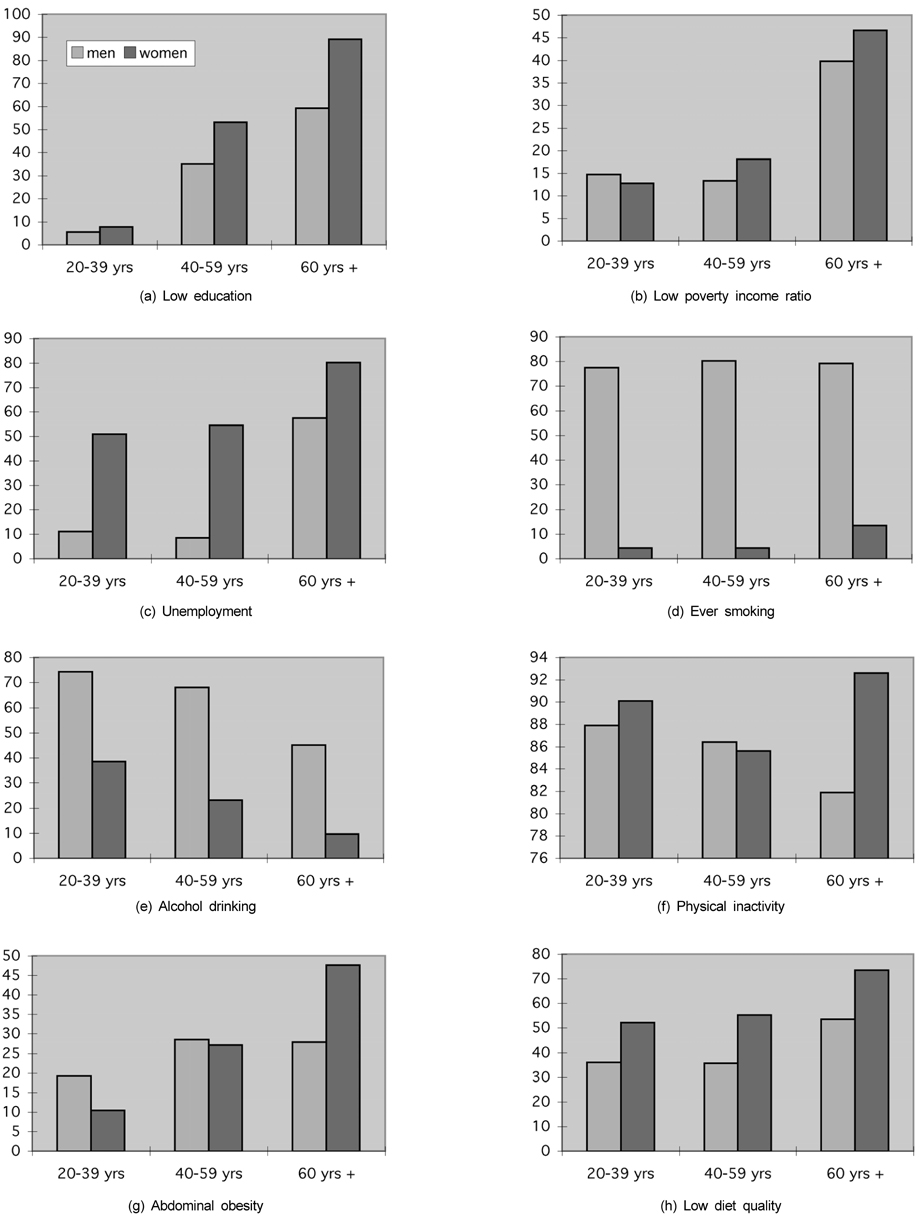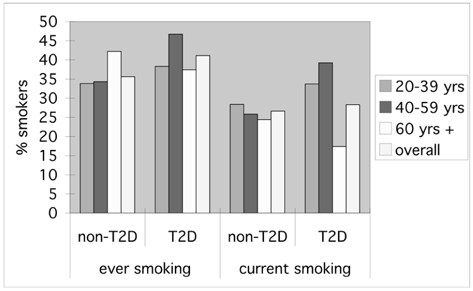Nutr Res Pract.
2009 Dec;3(4):286-294.
Risk factors of type 2 diabetes among Korean adults: The 2001 Korean national health and nutrition examination survey
- Affiliations
-
- 1Department of Nutritional Sciences. Connecticut NIH EXPORT Center for Eliminating Health Disparities among Latinos. University of Connecticut. Storrs, CT 06269-4017, USA. hrchung@nutrikorea.com
- 2Nutrition for the Future, Inc. B-1504 Daewoo The'O superium, Nakseongdae-dong, Kwanak-gu, Seoul 151-848, Korea.
- 3Department of Nutritional Sciences. Director, Connecticut NIH EXPORT Center for Eliminating Health Disparities among Latinos. University of Connecticut. Storrs, CT 06269-4017, USA.
Abstract
- This study aimed to identify risk factors for type 2 diabetes (T2D) in Korea, a rapidly changing country. Data of 5,132 adults aged 20-85 were used from the 2001 Korean Health and Nutrition Examination Survey. Multiple logistic regression was carried out to identify risk factors for T2D. Three models were specified: (i) socioeconomic and demographic factors (model 1: age, gender, education, poverty income ratio, employment), (ii) behavioral risk factors and covariates (model 2: obesity, physical activity, smoking, alcohol drinking, dietary quality, family history of T2D, co-morbidity) and (iii) socioeconomic, demographic, and behavioral factors (model 3). The prevalence of T2D was 7.4%. Less education (OR 1.41, 95% CI 1.08-1.84), age (OR 2.19, 95% CI 1.56-3.08 in 40-59 yrs, OR 4.05, 95% CI 2.76-5.95 in 60 yrs + comparing to 20-39 yrs) and abdominal obesity (OR 2.24, 95% CI 1.79-2.82) were risk factors for T2D even after controlling for other factors simultaneously. There was a significant association of T2D with ever smoking (OR 1.34, 95% CI 1.06-1.67). The relationship of age with T2D was modified by gender in model 1 and the relationship of smoking with T2D was modified by obesity in model 2. Less educated, older, obese or ever smokers were more likely to have T2D. Gender mediated the relationship of age, and obesity mediated the relationship of smoking, with T2D. Intervention programs for T2D in Korea should take the interactions among risk factors into account.
Keyword
MeSH Terms
Figure
Reference
-
1. Al-Delaimy WK, Willett WC, Mansen JE, Speizer FE, Hu FB. Smoking and mortality among women with type 2 diabetes: The nurses's health study cohort. Diabetes Care. 2001. 24:2043–2048.2. Centers for Disease Control and Prevention. Health status of Cambodians and Vietnamese- selected communities, United States, 2001-2002. MMWR Morb Mortal Wkly Rep. 2004. 53:760–765.3. Chen GLX, Wang JJ, Xing X, Yang W, Hu Y. Obesity, coronary heart disease risk factors and diabetes in Chenese: an approach to the criteria of obesity in the Chinese population. Obes Rev. 2002. 2002:167–172.4. Cho NH, Jang HC, Park HK, Cho YW. Waist circumference is the key risk factor for diabetes in Korean women with history of gestational diabetes. Diabetes Res Clin Pract. 2006. 71:177–183.
Article5. Dalstra JAA, Kunst AE, Borrell C, Breeze C, Cambois E, Costa G, Geurts JJ, Lahelma E, Van Oyen H, Rasmussen NK, Regidor E, Spadea T, Mackenbach JP. Socioeconomic differences in the prevalence of common chronic diseases: an overview of eight European countries. Int J Epidemiol. 2005. 34:316–326.
Article6. Ding EL, Song Y, Malik VS, Liu S. Sex differences of endogenous sex hormones and risk of type 2 diabetes- a systemic review and meta-analysis. JAMA. 2006. 295:1288–1293.
Article7. Fitzgerald N. Identification of risk factors mediating the associations of socioeconomic, cultural, and demographic factors with type 2 diabetes across ethnic groups. 2004. USA: University of Connecticut;PhD dissertation.8. Flegal KM, Kuczmarski RJ, Johnson CL. Overweight and obesity in the United States: Prevalence and trends, 1960-1994. Int J Obes Relat Metab Disord. 1998. 22:39–47.
Article9. Goodrow GJ, L'Hommedieu GD, Gannon B, Sites CK. Predictors of worsening insulin sensitivity in postmenopausal women. Am J Obstet Gynecol. 2006. 194:355–361.
Article10. Hosmer DW, Lemeshow S. Applied logistic regression. 2000. 2nd ed. New York. USA: John Wiley & Sons Inc.11. Hu FB, Manson JE, Stampfer MJ, Colditz G, Liu S, Solomon CG, Willett WC. Diet, lifestyle and the risk of type 2 diabetes mellitus in women. N Engl J Med. 2001. 345:790–797.
Article12. World Economic Outlook 2006. International Monetary Fund. 2007. 3/20/2007. http://www.imf.org/external/pubs/ft/weo/2006/02/index.htm.13. Kant AK. Indexes of overall diet quality: a review. J Am Diet Assoc. 1996. 96:785–791.14. Kawakami N. Effects of smoking on incidence of non-insulin dependence diabetes mellitus. Am J Epidemiol. 1997. 145:103–109.15. Khang YH, Cho HJ. Socioeconomic inequality in cigarette smoking : Trends by gender, age and socioeconomic position in South Korea, 1989-2003. Prev Med. 2006. 42:415–422.
Article16. Kim SW, Symons M, Popkin BM. Contrasting socioeconomic profiles related to healthier lifestyles in China and the United States. Am J Epidemiol. 2004. 59:184–191.
Article17. Kim DM, Ahn CW, Nam SY. Prevalence of obesity in Korea. Obes Rev. 2005a. 6:117–121.
Article18. Kim MH, Kim MK, Choi BY, Shin YJ. Educational disparities in the metabolic syndrome in a rapidly changing society--the case of South Korea. Int J Epidemiol. 2005b. 34:1266–1273.
Article19. Kim SM, Lee JS, Lee J, Na JK, Han JH, Yoon DK, Baik SH, Choi DS, Choi KM. Prevalence of diabetes and impaired fasting glucose in Korea. Diabetes Care. 2006. 29:226–231.
Article20. Ko MJ, Kim MT, Nam JJ. Assessing risk factors of coronary heart disease and its risk prediction among Korean adults : The 2001 Korea national health and nutrition examination survey. Int J Cardiol. 2006. 110:184–190.
Article21. Korean Society for the Study of Obesity. Report on cut-off point of body mass index and waist circumference for criteria of obesity and abdominal obesity among Korean. 2005. Seoul. Republic of Korea: 2–3.22. Leffondre K, Abrahamowicz M, Siemiatycki J, Rachel B. Modeling smoking history : A comparison of different approaches. Am J Epidemiol. 2002. 156:813–823.23. Margolis KL, Bonds DE, Rodabough RJ, Tinker L, Philips LS, Allen C, Bassford T, Burke G, Torrens J, Howard BV. Effect of oestrogen plus progestin on the incidence of diabetes in postmenopausal women: results from the women's health initiative hormone trial. Diabetologia. 2004. 47:1175–1187.
Article24. McNeely MJ, Boyko EB. Type 2 diabetes prevalence in Asian Americans. Diabetes Care. 2004. 27:66–69.
Article25. Miller A. Education, income inequality, and mortality : a multiple regression analysis. BMJ. 2002. 324:23–26.26. National Basic Livelihood Program. Ministry of Health and Welfare. 2006. Accessed on 8/20/2006. http://www.mohw.go.kr.27. 2003 statistical results about cause of death. National Statistical Office. 2006. Accessed on 8/15/2006. http://www.nso.go.kr.28. Oh SW, Shin SA, Yun YH, Yoo TW, Huh BY. Cut-off point of BMI and obesity-related comorbidities and mortality in middle-aged Koreans. Obes Res. 2004. 12:2031–2040.
Article29. Patja K, Jousilahti P, Hu G, Valle T, Qiao Q, Tuomilehto J. Effects of smoking, obesity and physical activity on the risk of type 2 diabetes in middle-aged finnish men and women. J Intern Med. 2005. 258:356–362.
Article30. Ryu JB, Lee KO, Kim YW. A sampling design for the 2001 national health and nutrition survey. Applied Statistics Research. 2001. 14:289–304.31. Sairenchi T, Iso H, Nishmura A, Hosoda T, Irie F, Saito Y, Murakami A, Fukutomi H. Cigarette smoking and risk of type 2 diabetes mellitus among middle-aged and elderly Japanese men and women. Am J Epidemiol. 2004. 160:158–162.
Article32. Singh GK, Hiatt RA. Trends and disparities in socioeconomic and behavioral characteristics, life expectancy and cause-specific mortality of native-born and foreign-born populations in the United States, 1979-2003. Int J Epidemiol. 2006. 35:903–919.
Article33. Sung EJ, SW S, Kim SW, Kim YS. Obesity as a risk factor for non-insulin-dependent diabetes mellitus in Korea. J Korean Med Sci. 2001. 16:391–396.
Article34. Swinburn B. The thrifty genotype hypothesis: How does it look after 30 years? Diabet Med. 1996. 13:695–699.
Article35. Toth MJ, Tchernof A, Sites CK, Poehlman E. Menopause-related changes in body fat distribution. Ann N Y Acad Sci. 2000. 904:502–506.
Article36. Wang Y, Rimm EB, Stampfer MJ, Willett WC, Hu FB. Comparison of abdominal adiposity and overall obesity in predicting risk of type 2 diabetes among men. Am J Clin Nutr. 2005. 81:555–563.
Article37. Wei M, Gaskill SP, Haffner SM, Stern MP. Waist circumference as the best predictor of noninsulin dependent diabetes mellitus (NIDDM) compared to body mass index, waist/hip ratio and other anthropometric measurements in Mexican Americans-a 7-yrea prospective study. Obes Res. 1997. 5:16–23.
Article38. Will JC. Cigarette smoking and diabetes mellitus: Evidence of a positive association from a large prospective cohort study. Int J Epidemiol. 2001. 30:554–555.
Article39. Willett WC, Dietz WH, Colditz GA. Guidelines for healthy weight. N Engl J Med. 2006. 341:427–434.
Article40. Wong MD, Shapiro MF, Boscardin J, Ettner SL. Contribution of major diseases to disparities in mortality. N Engl J Med. 2002. 347:1585–1592.
Article41. World Health Organization. Definition, diagnosis and classification of diabetes millets and its complications, WHO/NCD/NCS/99.2. Report of a WHO Consultation. 1999. Geneva. Switzerland:42. World Health Organization. Obesity: Preventing and managing the global epidemic. WHO Technical Report Series 894. 2000. Geneva:43. Zhang Q, Wang Y. Trends in the association between obesity and socioeconomic status in U.S. adults. Obes Res. 2004. 12:1622–1632.
Article
- Full Text Links
- Actions
-
Cited
- CITED
-
- Close
- Share
- Similar articles
-
- Relationship between Diabetes Mellitus and Anemia in Korean Adults-Based on the Korean National Health and Nutritional Examination Survey VI
- Prevalence of Abdominal Obesity and Associated Factors among Korean Adults: The 2001 Korean National Health and Nutrition Examination Survey
- Diabetes Risk Score for Korean Adults
- Factors Associated with Persistent Smoking in Diabetic Patients: The Seventh Korea National Health and Nutrition Examination Survey
- Trend Analysis in the Prevalence of Type 2 Diabetes According to Risk Factors among Korean Adults: Based on the 2001~2009 Korean National Health and Nutrition Examination Survey Data



